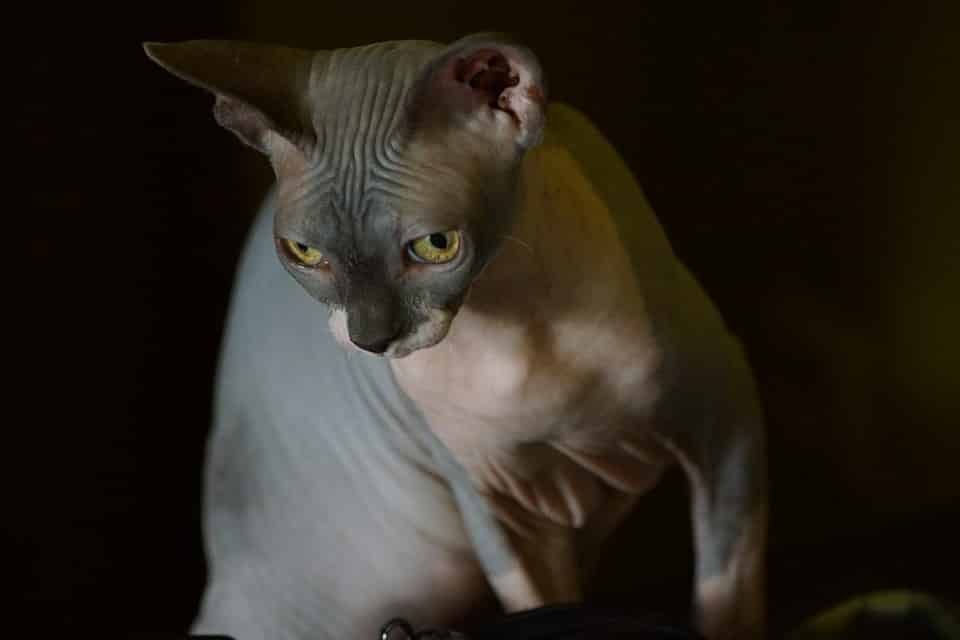
Whiskers are a sophisticated sensory mechanism. How do bald felines navigate the world without them?
Sphynxes and other hairless cats can balance without whiskers because whiskers do not regulate balance. Whiskers, however, play a role in several related functions, such as depth perception, proprioception, and even night vision. Bald cats may lack precision and agility in complex situations.
Hairless cats have adapted to living with fine whiskers or without any whiskers at all. However, having few or no whiskers makes it more challenging for cats to orient themselves in unfamiliar environments, especially outside.
Do Hairless Cats Have Any Whiskers?
Most cats have 24 vibrissae, or whiskers, on their faces. They also have finer vibrissae on their paws and chins.
Some Sphynxes and other hairless cats have fine short whiskers, which have a similar function but are not quite the same as those of furry cats. Many bald cats do not have any whiskers at all.
How Do Cats Balance?
Like all other mammals, the cat’s ability to balance is primarily regulated by its inner ear, which connects the middle and external ears. The cerebellum is the structure in the brain that ultimately is the control center of balance and movement. The tail also has a part in balancing but mostly to maintain balance rather than sense and evaluate the surroundings.
Whiskers do not have a role in balancing per se, so a hairless and whiskerless cat can walk and jump without losing balance. Whiskeys have other related functions that affect the ability to balance complex situations and navigate the surroundings.
What Do Whiskers Do For Cats?
Each vibrissa performs a sensory function for felines. For that reason, whiskers and eyebrows should never be trimmed. Cats can balance without them but the perception of depth and proprioception, or the ability to sense their movement and location, are impaired without whiskers and eyebrows.
– Proprioceptor
Cats can sense the vibration from their movement or the objects around them to feel where they are about their surroundings. This is one of the mechanisms that helps these animals maintain precision and grace and survive in a world that requires a quick reaction to any movement around them.
Amazingly, each vibrissa has a proprioceptor – a sensory organ – that perceives information from the environment and delivers it to its area in the brain.
– Night Vision Aid
Whiskers are particularly important at night. Cats can see much better than us in the dark, of course, but their eyes do not perceive depth quite as well without light. Whiskers contribute to the animal’s ability to be aware of the surroundings in the dark.
– Depth Perception
Whiskers also allow the animals to gauge the depth and size of a tight space, in the light and the dark. They help to estimate the surroundings via tactile contact and perceiving vibration.
– Communication
In addition, cats communicate their state with their whiskers, among other body language ways. Their whiskers look relaxed when the cat is calm and sleepy. Any arousal causes the animal’s whiskers to face forward to communicate a range of states, from playfulness to defensiveness.
The website of VCA Hospitals’ has a detailed article on the function of cat whiskers.
How Sphynx Cats Live Without Whiskers
For a cat that is used to living with a full set of whiskers and eyebrows, losing several whiskers affects orientation and perception until the whiskers grow back. It is not the same for cats who never had whiskers because they adapt to living without them.
Sphynxes and other bald cats rely on perceiving the world through other sensory organs. So, they function fine without vibrissae and can certainly balance without them. However, hairless cats still miss out on the functions of whiskers that other sensory organs cannot replicate.
Bald cats do not have such impeccable depth perception and may not react as quickly when they fall because their proprioception is less effective.
Sphynxes and other hairless felines are less adapted to functioning in the dark. Even their daytime vision may be affected since cats use whiskers to study objects near them.
To Sum Up
Having no or having few vibrissae is a characteristic that makes it challenging for bald cats to survive outdoors. Having no fur to insulate and protect them is another, more obvious, feature that makes these pets more vulnerable outside. Sphynxes and other bald feline beauties are not equipped to be outdoor animals.
Living at home, with all the protections available from the great outdoors, enables them to function just fine without whiskers.
Recent Posts
Clown Killifish Clown Killifish (Epiplatys annulatus) are great fish for beginners, as well as people who want to avoid having a lot of equipment for their aquariums. They do well in community...
Border collies, and other herders, such as Shelties, Aussies, and corgis, are bright and energetic family pets. It is wise to consider if your household is the right fit for these dogs. You may...

